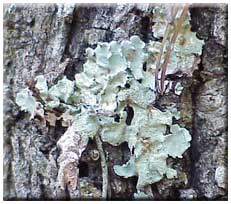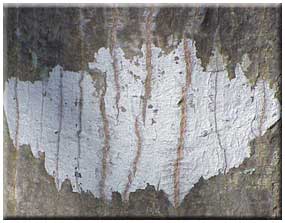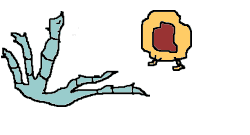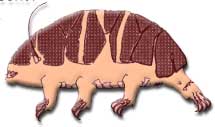
|
| Lichens, Tardigrades, and SO2 | Creating the Context Background Info |
 |
Creating the Context Home Research Focus Background Info Research Methods Data Submission Results of Study Data Analysis Conclusion Further Research Guided Research Research Question Background Info Research Methods Data Submission Results of Study Data Analysis Conclusion Further Research Research Values Student Research Doing Research Publish View Tools Discussions Email List Lichen Links Lichen Map Image Bank Project Awards |
LichensLichens are small, nondescript, often overlooked organisms. Once we notice them growing on the surfaces of trees, rocks, up the sides of buildings, and in mossy carpets in our forests, we cannot fail to admire the way in which they color our world. Lichens are actually two organisms existing in a symbiotic relationship known as mutualism. Lichens are typically composed of a green algae and a fungus. Lichens can also be composed blue-green algae, yellow-green algae, or cyanobacteria living in association with different kinds of fungi.Lichens are classified based on the fungal component. The fungi are either
 They appear in a wide variety of habitats because they can tolerate, and in fact thrive,
under difficult environmental conditions. Lichens are often categorized into morphological
types termed:
They appear in a wide variety of habitats because they can tolerate, and in fact thrive,
under difficult environmental conditions. Lichens are often categorized into morphological
types termed:
They are frequently found in harsh environments that would normally not support either of the symbiotic partners alone. Lichens are often the first colonists of rock outcrops and set the stage for the ecological succession of other organisms. The algae manufactures and provides itself and the fungus with carbohydrates and some vitamins. Some  blue-green algae can even fix nitrogen from the air. In turn, the fungus
provides the alga with certain physical protection, it obtains water vapor from
the air, providing moisture for the algae. In addition the fungus converts the
carbohydrate produced by the algae into a sugar alcohol for food storage. In
addition to this relationship between the two organisms, lichens have special
adaptations permitting them to withstand moisture and temperature extremes.
When moisture is available, it is taken up by the fungus leading to a mechanical
change which allows more light to get through, triggering algal photosynthesis.
When the atmosphere is dry the lichen is dormant and does not grow.
blue-green algae can even fix nitrogen from the air. In turn, the fungus
provides the alga with certain physical protection, it obtains water vapor from
the air, providing moisture for the algae. In addition the fungus converts the
carbohydrate produced by the algae into a sugar alcohol for food storage. In
addition to this relationship between the two organisms, lichens have special
adaptations permitting them to withstand moisture and temperature extremes.
When moisture is available, it is taken up by the fungus leading to a mechanical
change which allows more light to get through, triggering algal photosynthesis.
When the atmosphere is dry the lichen is dormant and does not grow.
 FLASH Animations:
FLASH Animations: For more information on
Lichen Related Links: Tardigrades
Tardigrades live in lichens and are unusual organisms that most people would rarely see. In fact, lodged within the lichens is a surprising diversity of microscopic invertebrates and protozoan that awaits reviving. These animals can survive periodic drying that occurs naturally in lichens by entering a special metabolic state called cryptobiosis. During cryptobiosis microinvertebrates weather dry conditions by suspending all but the most vital life functions. These microscopic animals range from 0.1 to 1.0 millimeters and live wherever trees and lichens grow. Samples of lichens with as many as five species of tardigrades as well as rotifers, nematodes mites, small insect larvae and various protozoa have been found. Tardigrades are distributed worldwide and thrive in diverse habitats including marine, terrestrial and freshwater environments. Terrestrial tardigrades become active only when surrounded and rehydrated by water. Reanimated tardigrades cling to substrate and search slowly for food. These "water bears" as they are commonly called, use four pairs of stumpy, clawed legs to lumber through the water. When surrounding water evaporates, tardigrades can eliminate as much as 90% of their body water. This loss of body water is called anhydrobiosis and leads to a cryptobiotic state in which tardigrades assume a desiccated form called a tun. Tardigrades can survive for months or even years as tuns, remaining inactive until reanimated with water. When moistened, a 120 year-old museum specimen of dried moss yielded tardigrades showing signs of life. For much more information on tardigrades, check out the Background Information of the Tardigrade Survey project! Environmental MonitoringThe lichens, and the community living on them, may provide a useful bioindicator for air pollution since they derive their water and essential nutrients mainly from the atmosphere rather then from the soil. This community is composed of many microscopic organisms such as roundworms and tardigrades. The population numbers and species diversity in these microscopic inhabitants can also be influenced by atmospheric pollutants. It also helps that they are evergreen and able to react to air pollutants year round. In addition, compared with most physical/chemical monitors, they are inexpensive. They can also be used to measure toxic elemental pollutants and radioactive metals because they bind these substances in their fungal threads where they concentrate over time. The following information comes from: Sulfur Dioxide and Lichens by Barbara Tinker, Global Lab Project. Lichens are injured by sulfur dioxide (SO2). Rose (1975) has calculated that more than one-third of England and Wales has lost nearly all its epiphytic lichens, the most delicate shrubby lichens, largely due to the sulfur-dioxide emissions of coal-burning power plants. In Northern Siberia, an area of the Soviet Union which is very polluted, the number of lichen species has fallen from 50 to about 3, and the lichen production in general stands at about 1 or 2% of normal levels, threatening the reindeer diet; in Alaska there are similar concerns about lichen reduction and the caribou diet. Losses in other parts of the world reflect the increasingly poor quality of the earth's air and the need for early warning bioindicators such as lichens. This pollutant has natural sources, such as volcanic eruptions and sea spray. By far the largest source for it, however, is the combustion of fossil fuels, automobile emissions, and some industrial processes. The pollutant is carried in the atmosphere until rained out or deposited as dry particles or as gas. Sulfur dioxide combines with moisture in the atmosphere to form sulfurous acid (H2SO3) or sulfuric acid (H2SO4). When this happens with rainwater, the result is acid rain. All these forms of sulfur are harmful to lichens and plants. Lichens have also shown sensitivity to some other pollutants, such as heavy metals and ozone, but for the most part lichen damage can be attributed to SO2 . The effect of pollution upon lichens can depend on the
pH of the substrate, the surface on which the lichen grows. In general,
an alkaline substrate such as basic bark or limestone counteracts the acidity
of SO2 pollution. As acid rain falls on a substrate, one kind of lichen
growth form will often be replaced by another more tolerant form. In areas
of high pollution lichens may be found only on sites such as wounds on
trees and on sandstone walls, which have high (basic) pH. Scientists have
found that, with considerable SO2 pollution in an area;
Lichen communities are either weakened or killed by pollution with a consequent loss of species diversity. Lacking the protective cuticle of higher plants, lichens accumulate sulfur dioxide in their thalli bodies in sufficient concentrations to quickly injure or kill them. They also accumulate metals, some of which are toxic, and as they store these toxic metals safely in their hyphal cell walls, they can be professionally evaluated for toxin levels. The lichen's symptoms of sulfur dioxide death are distinctive. The lichen turns from its usual gray or green hues to the more unusual brown, yellow, pink or white as its chlorophyll is lost. It starts to peel away from its substrate. The sizes of lichen thalli often decrease, especially in fruticose lichens. Fewer spores are produced. The centers of circular lichen colonies usually die first, leaving rings and crescent patterns on rocks or trees.
|
| © 1996-2006 PathFinder Science |